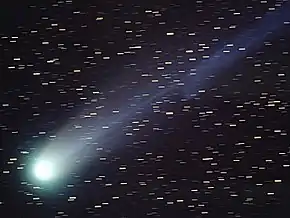30P/Reinmuth
Comet 30P/Reinmuth, also known as Comet Reinmuth 1, is a periodic comet in the Solar System, first discovered by Karl Reinmuth (Landessternwarte Heidelberg-Königstuhl, Germany) on February 22, 1928.
| Discovery | |
|---|---|
| Discovered by | Karl Reinmuth |
| Discovery date | February 22, 1928 |
| Alternative designations | 1928 D1, 1934 V1 |
| Orbital characteristics A | |
| Epoch | July 1, 2009 (2455013.5) |
| Aphelion | 5.664 AU |
| Perihelion | 1.884 AU |
| Semi-major axis | 3.774 AU |
| Eccentricity | 0.5008 |
| Orbital period | 7.33 yr |
| Inclination | 8.13° |
| Jupiter MOID | 0.159 AU (23,800,000 km)[1] |
| Last perihelion | 2017-Aug-19 April 19, 2010[2][3] December 24, 2002[2][3] |
| Next perihelion | 2024-Aug-17[4] |
First calculations of orbit concluded a period of 25 years, but this was revised down to seven years and speculation this was the same comet as Comet Taylor, which had been lost since 1915. Further calculations by George van Biesbroeck concluded they were different comets.
The 1935 approach was observed though not as favourable, in 1937 the comet passed close to Jupiter which increased the perihelion distance and orbital period.
Due to miscalculations, the 1942 appearance was missed, but it has been observed on every subsequent appearance since.
The comet nucleus is estimated to be 7.8 kilometers in diameter.[1]
References
- "JPL Small-Body Database Browser: 30P/Reinmuth 1". Jet Propulsion Laboratory. 2010-01-04. Retrieved 2010-02-26.
- Seiichi Yoshida (2009-09-30). "30P/Reinmuth 1". Seiichi Yoshida's Comet Catalog. Retrieved 2010-03-01.
- Syuichi Nakano (2003-12-08). "30P/Reinmuth 1 (NK 1011)". OAA Computing and Minor Planet Sections. Retrieved 2010-03-01.
- MPC
External links
- Orbital simulation from JPL (Java) / Horizons Ephemeris
- 30P/Reinmuth magnitude plot for 2010
- 30P at Kronk's Cometography
- 30P at Kazuo Kinoshita's Comets
- 30P at Seiichi Yoshida's Comet Catalog
| Numbered comets | ||
|---|---|---|
| Previous 29P/Schwassmann–Wachmann |
30P/Reinmuth | Next 31P/Schwassmann–Wachmann |

